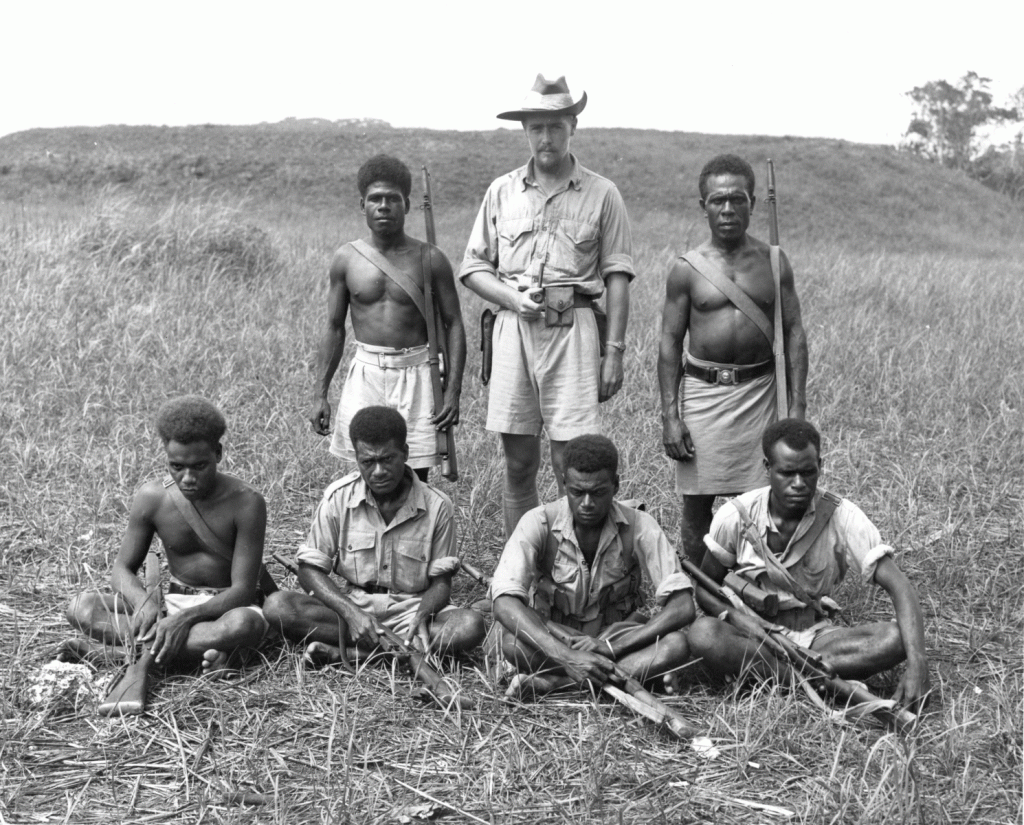

After Imperial Japan formally kicked off World War II in the Pacific by attacking the U.S. Navy fleet at Pearl Harbor, Hawaii, in December 1941, Japanese forces made lightning-fast advances in the South Pacific. By early 1942, Japan had occupied all of southeast Asia, threatening India in the west, Australia in the south, and Hawaii in the east.
Surging from former Imperial German island colonies in the central Pacific that Japan had acquired at the end of World War I, they quickly overran island archipelagos, such as the Admiralties and the Solomons in the far South Pacific, close to Australia. These remote islands often had plantations owned by individuals and corporations and administered by Australian, New Zealand, and British nationals.
While the Japanese conquest was rapid, it had been long anticipated by Australian, New Zealand and British military intelligence agencies. As far back as the 1920s and 1930s, plantation owners and managers on these remote islands were actively recruited, trained, and supplied with radios and other equipment by Australian military intelligence. When the war broke out, these civilian volunteers became the Coastwatchers. The force grew to over six hundred personnel serving behind the Japanese lines.
Formally known by names such as the Coast Watch Organisation, Combined Field Intelligence Service or Section C, Allied Intelligence Bureau, they began to observe and report enemy movements and rescue nationals from Allied nations stranded by the Japanese onslaught. The work was dangerous, and in addition to working behind Japanese lines with extremely limited resources and supplies, they had to contend with life-threatening tropical diseases. Many civilian Coastwatchers were rugged, independent types who had good relations with and the trust of local Indigenous island peoples. Some of the islands had Indigenous police, constabulary, and paramilitary organizations in place before the war. When the Imperial Japanese demonstrated their typical contempt for conquered peoples and implemented heavy-handed control over the Indigenous populations, the Coastwatchers soon had many ready recruits.
With radar in its infancy, and given the vast distances involved, the Coastwatchers and their Indigenous allies became indispensable in providing early warning of Imperial Japanese aircraft and ships headed out to attack the Allies in various island campaigns, such as Guadalcanal. U.S. Admiral William Halsey Jr., the acerbic commander of Naval forces during the Solomon Islands campaign, gave high praise to the Coastwatchers: “The Coastwatchers saved Guadalcanal, and Guadalcanal saved the South Pacific.”
Many downed Allied fliers and shipwrecked sailors were also rescued by Indigenous people working with coastwatcher organizations, who sometimes had to barter for these airmen with neutral tribes who had not yet encountered the Japanese. When future U.S. president John F. Kennedy’s patrol boat, PT 109, was destroyed in action against the Japanese Navy in the waters around Guadalcanal, Kennedy, and the surviving members of his crew were rescued through the efforts of an Australian coastwatcher. In July 2022, Australian Coastwatchers James Burrowes and Ronald George Lee were still living and were honored in a wreath-laying ceremony by U.S. Ambassador to Australia Caroline Kennedy, daughter of President Kennedy, at the Australian War Memorial in the capital city of Canberra.

“The event was a very special and personal acknowledgment by Ambassador Kennedy and the US government of the role we had as Aussie Coastwatchers eight decades ago. I am proud at 98 to meet Her Excellency and share Coastwatcher stories. The time I spent in the Solomons and other locations as a Coastwatcher is as vivid today as it was then. It has been an honor to participate in this memorial event,” Australian World War II veteran Mr. Ronald (Dixie) George Lee said.
As the war in the South Pacific progressed, the traditional role of coast watching organizations to observe, and report expanded to the even more dangerous work of reconnoitering potential landing beaches as the Allies began their strategic island-hopping campaign towards the home islands of Japan. Forehand knowledge of the reefs, tides, and shore conditions of remote, Japanese-held islands was critical to successful amphibious assaults. Although many Coastwatchers were formally commissioned as officers in the Australian Naval Reserves, for their protection in case of capture, this was disregarded by the Japanese. In 1942, 17 New Zealand Coastwatchers were captured in the Gilbert Islands and were executed by the Japanese in October 1942 following an American air raid, part of the preparation for the attack on Tarawa by the U.S. Marines.
Although they rarely engaged in open combat, the Coast Watchers performed missions, such as beach reconnaissance and organizing local forces in occupied territory, that would later come under unconventional warfare units such as the U.S. Navy SEALS, the British Special Air Service, and U.S. Special Forces.
